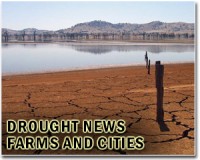 |
Santa Barbara CA (SPX) Feb 01, 2011 The increased frequency of drought observed in Eastern Africa over the last 20 years is likely to continue as long as global temperatures continue to rise, according to UC Santa Barbara scientist Park Williams. The new research, published in Climate Dynamics, indicates that more drought poses increased risk to millions of people in Kenya, Ethiopia, and Somalia, who currently face potential food shortages. "Forecasting precipitation variability from year to year is difficult, and research on the links between global change and precipitation in specific regions is ongoing so that more accurate projections of future precipitation can be developed," said Williams, first author and postdoctoral fellow in the Department of Geography. Warming of the Indian Ocean, which causes decreased rainfall in eastern Africa, is linked to global warming. These new projections of continued drought contradict scenarios previously projected by the Intergovernmental Panel on Climate Change which predict increased rainfall in Eastern Africa. This new research supports efforts by the USGS and the U.S. Agency for International Development to identify areas of potential drought and famine in order to target food aid and help inform agricultural development, environmental conservation, and water resources planning. "Global temperatures are predicted to continue increasing, and we anticipate that average precipitation totals in Kenya and Ethiopia will continue decreasing or remain below the historical average," said co-author Chris Funk, USGS scientist. "The decreased rainfall in Eastern Africa is most pronounced in the March to June season, when substantial rainfall usually occurs. Although drought is one reason for food shortages, it is exacerbated by stagnating agricultural development and continued population growth." As the globe has warmed over the last century, the Indian Ocean has warmed especially fast. The resulting warmer air and increased humidity over the Indian Ocean produce more frequent rainfall in that region. The air then rises, loses its moisture during rainfall, flows westward, and descends over Africa, causing drought conditions in Ethiopia and Kenya. Williams explained that it is also important to note that while sea-surface temperatures are expected to continue to increase in the Indian Ocean, causing an average decrease in rainfall in Eastern Africa, there will still be very wet years due to the many factors that influence precipitation. The scientists compiled existing datasets on temperature, wind speed, and precipitation to see what was driving climate variations in the tropical Indian and Pacific Ocean region. Most of the Indian Ocean warming is linked to human activities, particularly greenhouse gas and aerosol emissions. The Indian Ocean has warmed especially fast because it is quickly being encroached upon by the Tropical Warm Pool, an area with the warmest ocean surface temperatures anywhere. This research supports efforts by the USGS and the U.S. Agency for International Development, through the Famine Early Warning Systems Network. FEWS NET is a decision support system that helps target more than $2 billion of food aid to more than 40 countries each year. Through this system, scientists are helping with early identification of agricultural drought that might trigger food insecurity.
Share This Article With Planet Earth
Related Links University of California - Santa Barbara Climate Science News - Modeling, Mitigation Adaptation
 China farmers to get $15 bn subsidies amid drought
China farmers to get $15 bn subsidies amid droughtBeijing (AFP) Jan 21, 2011 China says it had earmarked about $15 billion in subsidies for millions of farmers who have been hit by a severe drought that has driven prices as the government tries to battle inflation. The dry spell in the north and south has affected about four million hectares (9.9 million acres), official figures show, and has been blamed for destroying crops. Farmers will receive 98.6 billion yua ... read more |
|
| The content herein, unless otherwise known to be public domain, are Copyright 1995-2010 - SpaceDaily. AFP and UPI Wire Stories are copyright Agence France-Presse and United Press International. ESA Portal Reports are copyright European Space Agency. All NASA sourced material is public domain. Additional copyrights may apply in whole or part to other bona fide parties. Advertising does not imply endorsement,agreement or approval of any opinions, statements or information provided by SpaceDaily on any Web page published or hosted by SpaceDaily. Privacy Statement |